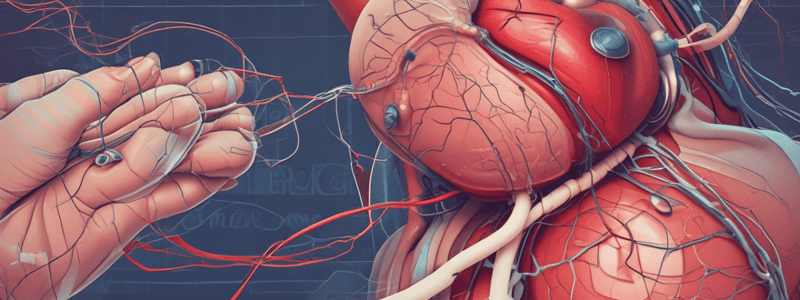Podcast
Questions and Answers
What is the primary reason for the difference in time between S1 and S2 compared to the time between S2 and the next S1?
What is the primary reason for the difference in time between S1 and S2 compared to the time between S2 and the next S1?
- The difference in blood pressure between systole and diastole
- The difference in the velocity of blood flow through the mitral/tricuspid and aortic/pulmonic valves
- The variation in valve closure timing between mitral/tricuspid and aortic/pulmonic valves (correct)
- The alteration in cardiac output between systole and diastole
In which region of the chest wall is the second heart sound typically heard?
In which region of the chest wall is the second heart sound typically heard?
- The apex of the heart
- The second right and left intercostal spaces (correct)
- The mid-clavicular line
- The left fourth intercostal space
During which phase of the cardiac cycle does the pulmonic valve close?
During which phase of the cardiac cycle does the pulmonic valve close?
- Ventricular contraction (systole)
- Isovolumic contraction
- Atrial contraction
- Ventricular relaxation (diastole) (correct)
What is the normal pattern of S2 in younger patients?
What is the normal pattern of S2 in younger patients?
Why is S1 not split?
Why is S1 not split?
What is the characteristic rhythm produced by the presence of extra heart sounds S3 and S4?
What is the characteristic rhythm produced by the presence of extra heart sounds S3 and S4?
Flashcards are hidden until you start studying
Study Notes
Cardiac Examination: Auscultation
- Auscultation Overview: Utilizes a stethoscope diaphragm to assess heart sounds.
S1 (First Heart Sound)
- Location: Loudest over the left fourth intercostal space, associated with the mitral and tricuspid valve areas.
- Mechanism: Produced by the closure of the mitral and tricuspid atrioventricular valves during ventricular contraction (systole).
S2 (Second Heart Sound)
- Location: Heard along the second right and left intercostal spaces, corresponding to the aortic and pulmonic valve regions.
- Mechanism: Results from the closure of the pulmonic and aortic semilunar valves during ventricular relaxation (diastole).
Timing of Heart Sounds
- S1 to S2 Interval: The time between S1 and S2 is shorter than the time from S2 back to the next S1, helping identify which sound corresponds to which valve closure.
- Physiologic Splitting of S2: Normal in younger patients, consisting of two parts:
- A2 (Aortic Closure) and P2 (Pulmonic Closure).
- During inspiration, increased venous return delays pulmonic valve closure, leading to a noticeable split (A2 followed by P2).
- On expiration, sounds merge, producing a single S2.
S1 Characteristics
- No Splitting: Mitral and tricuspid closure occurs so closely that individual sounds are not discernible.
Extra Heart Sounds (S3 and S4)
- Description: Create a gallop rhythm, audible around the fourth intercostal space along the mid-clavicular line.
- Normal Variability: Considered normal in individuals aged 20-30.
Studying That Suits You
Use AI to generate personalized quizzes and flashcards to suit your learning preferences.



